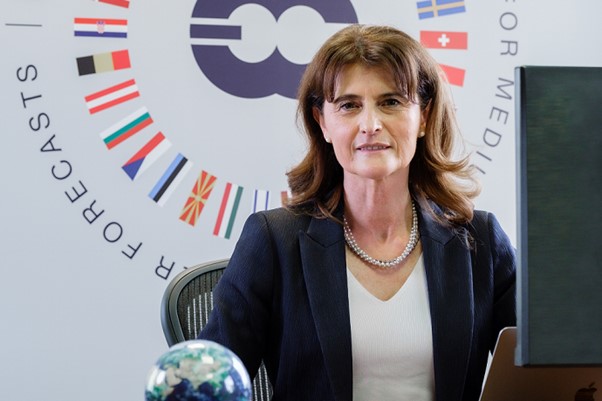

Copyright: Stephen Shepherd photography
An upgrade of the Integrated Forecasting System (IFS) to Cycle 48r1 is at the centre of our plans for 2023, ECMWF Director-General Florence Rabier has said. In an interview that previews the Centre’s activities this year, she also highlights other developments in forecasting and computing, and she sets out plans for the EU’s two Copernicus services run by ECMWF and the EU’s Destination Earth (DestinE) initiative, in which ECMWF participates.
What will be different for ECMWF in 2023 compared to the previous year?
The year 2022 was one of transition, with our new sites in Bologna, Italy, and Bonn, Germany, settling in, and with our operations being migrated to our new high-performance computing facility (HPCF) in Bologna. We didn’t have an upgrade of the IFS that year but instead prepared the one planned for June this year, to Cycle 48r1. This new cycle is one of the highlights of the coming year and contains a lot of scientific improvements. Many of them are related to major enhancements of our ensemble forecasts, which depend on increased computing power. This is thus a major upgrade, benefiting from the investment in computing we and our Member States made.
Which main novelties will Cycle 48r1 bring?
The two main innovations are a big upgrade in resolution of our global medium-range ensemble forecasts, from 18 km to 9 km, and more frequent extended-range forecasts with more ensemble members. The medium-range upgrade means that we will have just one resolution up to 15 days ahead, while currently we have a single high-resolution forecast at 9 km and an ensemble at 18 km. This is the culmination of our goal to make ensemble forecasts our main output in the medium range. On top of this forecast resolution upgrade, we also improve the resolution of the 4D-Var data assimilation. For the extended range, up to 46 days ahead, we found that high resolution is not the main factor determining the quality of forecasts. Instead, what matters more is the number of ensemble members. So in the upgrade we will increase it from 51 to 101. We will also increase the frequency of extended-range forecasts from twice a week to daily. The result is a big improvement in the quality of our ensemble forecasts in the medium range and the extended range.

Tropical storm strike probability maps for week 4 for the extended-range forecast starting on 7 January 2021, showing (a) the strike probability produced with a 51-member ensemble and (b) the strike probability produced with a 101-member ensemble, both in the real-time forecast configuration.
Can you give an overview of other changes in Cycle 48r1?
A culmination of years of technical work will be the implementation of OOPS, the object-oriented prediction system, which we developed in collaboration with our Member States. That’s essentially a more flexible way to run the data assimilation. We are also going to use some observations at higher resolution, such as scatterometer winds, and we are going to use more all-sky and all-surface observations. There’s also a multi-layer snow model, and a new hybrid-linear ozone scheme, which will be interacting with radiation.
What other developments are we working on?
These include new models for ocean and sea ice, which need to be integrated into all our applications. We are also working to replace the stochastic physics scheme that’s used to help create slightly different forecasts to reflect their uncertainty. One big advantage of the scheme that’s being developed, Stochastically Perturbed Parametrizations (SPP), is that it conserves certain quantities, such as energy and humidity, better than the current scheme. It can also be extended more easily to components of the Earth system such as the ocean or the land, and it takes account of uncertainties where they occur, i.e. in each parametrization of physical processes. In addition, we are working to improve the way the Ensemble of Data Assimilations (EDA) is built, and we are gradually extending the window of data assimilation to move closer to observations. We are also continuing to work on a different dynamical core, called the Finite-Volume Module (FVM), which may one day replace the current dynamical core of the IFS to achieve efficient higher-resolution global forecasts. Finally, we’ll continue on our way to open data by releasing more fields. A wide range of data has already been made available for anybody to use.

Image: NicoElNino / iStock / Getty Images Plus
What big developments can we expect in Copernicus and DestinE?
The biggest development is a new anthropogenic greenhouse gas emissions Monitoring and Verification Support Capacity (CO2MVS), which is a major and ambitious EU project. This is being worked on to become part of the EU’s Copernicus Atmosphere Monitoring Service (CAMS), which is run by ECMWF. Estimating the emissions of greenhouse gases caused by humans is not easy, so a lot of development is going into that. The EU’s Copernicus Climate Change Service (C3S), also run by ECMWF, will provide to users the ERA5 climate reanalysis back to 1940. It will also prepare for the next version of climate reanalysis, ERA6, which will have new components and better bias correction. In the EU initiative DestinE, which ECMWF develops alongside EUMETSAT and ESA and which has just finished its first year, there will be a lot of work on interactive workflows and higher resolution, including on verifying high-resolution forecasts. In the context of DestinE, we are also porting our IFS to EuroHPC supercomputers, which are very powerful and will demonstrate our capacity to adapt to a different computer infrastructure.
What changes are on the cards in computing this year?
We’ve just published our Software Strategy, which is the strategy for all of our code outside the IFS. Regarding the IFS, we are adapting our code to run some of it on GPUs. The Hybrid2024 project, for which we work very closely with Météo-France, aims to produce a version of the IFS model able to run on hybrid architectures, with a readiness date in 2024. Also, the European Weather Cloud, a cloud computing infrastructure which we have created together with EUMETSAT, will become operational. At the same time, the C3S Climate Data Store will be turned into a joint C3S/CAMS Climate and Atmosphere Data Store. In parallel, we are a key partner in the EU’s WEkEO platform for providing Copernicus atmosphere, climate, marine and land services. We are also going to develop a new data storage strategy, and we are holding the 20th workshop on HPC in meteorology in Bologna in October.

Image: tarasov_vl/iStock/Getty Images Plus
Finally, what plans are there for machine learning?
We published a machine learning roadmap as early as January 2021. We’ve been working on this in different fields: monitoring data, data assimilation, correcting model errors, emulating certain components of the model, post-processing. We’ve also prepared a Massive Open Online Course (MOOC) on machine learning in weather and climate, which is taking place now. This year we are going to ramp up our efforts because machine learning may take on an even more important role than we thought two years ago. A machine learning tool to detect and classify observation anomalies will become operational, and we’ll plan for activities to test at scale in the years to come.
In a nutshell, what is ECMWF’s aim in 2023?
2023 is the year when we reap the benefits of our new setup as a multi-site organisation. It is also a year when we use our new computing infrastructure and capability to improve our numerical weather prediction for delivering the best possible forecasts to our Member States. Last but not least, it is a year when we focus on science going forward, with an open mind towards disruptive technologies.
